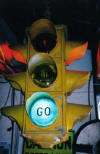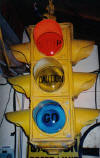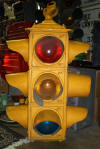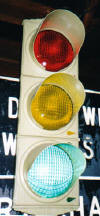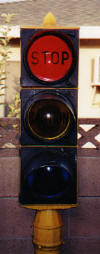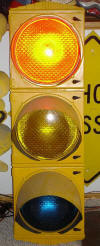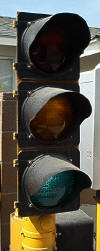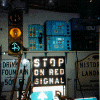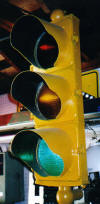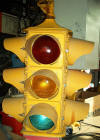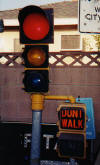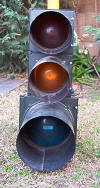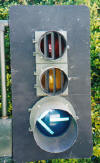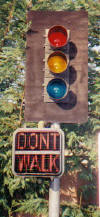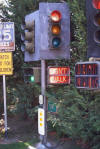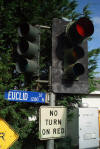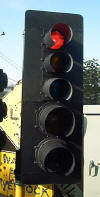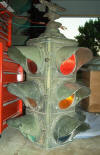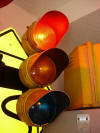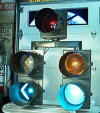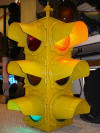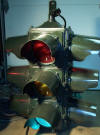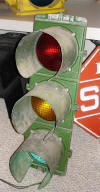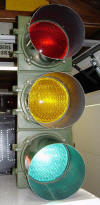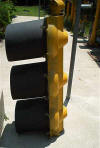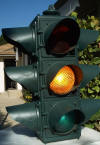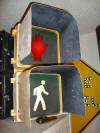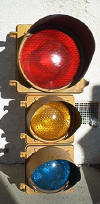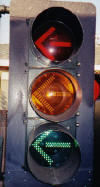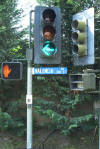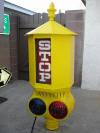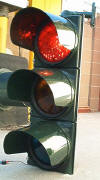|
|
Vehicular Signals |
|
![]()
Be sure to click on the photos for closer views!
Listings proceeded by a "*" symbol have animated photos...just click to view the signal in action!
![]()
Crouse-Hinds
* CROUSE-HINDS 4-WAY- This is the "4-way" version of the traffic signal. It had four signals all rolled into one unit. This particular signal was manufactured by Crouse-Hinds circa 1945. Crouse-Hinds officially referred to these as the as the type "D" non adjustable signal and they were manufactured during the post war years of 1945-1952. One thing that made this particular signal unusual is that a compass (N,E,S,W) was cast into the top of the signal. I'm not sure why they did this, but it is a feature that's unique to Crouse-Hinds and W.S. Darley Signals.
It was a popular type in the 40s and 50s. All the medium to large sized towns had at least one of these hung in the middle of their town to slow the traffic down through town---even if it really wasn't needed! Click on the picture to watch the signal sequence!
Another view of one of my Crouse-Hinds 4-way signals. The signal has the original paint and embossed lenses with legends of the three safety commands. The lenses shown here are the original lenses that included the basic commands "STOP, CAUTION", and "GO" along with color. The lenses also sport the "CH" cube logo. The lenses shown here have been restored to their original black color. When I received the signal, the paint on the commands was almost entirely flaked away...leaving just the ridged glass letters.
Here is a second Crouse Hinds "D" type 4-way signal in my collection, but with quite unusual visors over the middle yellow sections. They are part "tunnel" and part "cutaway". I'm not completely sure what was the particular reason for these "tunnaway" visors, but it adds to the mystique of the signal. Since this picture was taken, I have replaced these unusual visors with the standard cutaway style. This signal features the original cloth wiring inside and the, unique to Crouse-Hinds only, "smiley-style" lenses. This particular lens uses a refractive lens pattern that looks like a "smiley face" when seen close up. There are two types of these lenses represented in this signal. The older style with larger "beads" and ridges and the newer style with smaller "beads".
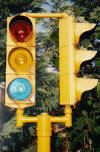 * CROUSE-HINDS 2 WAY- Here is a typical example of what a lot of
towns used more recently in their central business district
(CBD). The intersections basically had 4 poles-one on each corner, with a 2 way
signal like this mounted on top. It was an efficient, simple design but became
problematic when the adjacent stores and shops employed neon and other colored
lights. The background became "busy" and back plates and overhead signals
started to be used to overcome this problem. There are still a few of the "old
style" intersections left, however.
This signal is next generation (early 1950's) model "DT" (stands for
"dust tight").
Click on the picture to see it sequence!
* CROUSE-HINDS 2 WAY- Here is a typical example of what a lot of
towns used more recently in their central business district
(CBD). The intersections basically had 4 poles-one on each corner, with a 2 way
signal like this mounted on top. It was an efficient, simple design but became
problematic when the adjacent stores and shops employed neon and other colored
lights. The background became "busy" and back plates and overhead signals
started to be used to overcome this problem. There are still a few of the "old
style" intersections left, however.
This signal is next generation (early 1950's) model "DT" (stands for
"dust tight").
Click on the picture to see it sequence!
This Crouse-Hinds model "D" single faced signal once stood guard at the Southern California intersection of U.S. 101 and Ortega Highway...immediately adjacent to the old Mission San Juan Capistrano! As the photo shows, these older signals used latches for door access and used an "art deco" style ornamental design. Another trait these older signals employed were integral visors...that is, that the visors were built as part of the signal itself, not as a replaceable piece! Use of replaceable visors became a popular idea soon after, because once the signal was damaged, the entire unit had to be replaced. This photo is also a good example in showing the "smiley lens" configuration that was popular in the 40's and 50's.
Another example of an early Crouse hinds with the fancy ornamental final at the top and post adapter. This signal also sports the original lettered lenses. The color scheme on this signal was the popular yellow body with black visors/ doors. Note also, that the art deco parts of the signals have been "trimmed". his was because originally the signal mountings were flush with the signal head and the extrusions had to be cut. Sad, but the signal still retains its distinctive character. The single head models were known as either" D" or "DT" depending on if they had cast aluminum reflector frames or stamped aluminum. The example pictured here is a "DT" model. These are slightly later in the timeline than the type "D".
Crouse Hinds also made a 12" lens version of the "Art Deco" style signal. These were used primarily in overhead mast arm or span wire applications. They represented one of the first uses of the larger lens size as vehicle speeds increased and signal visibility became more of an issue.

NEWER CROUSE-HINDS 8" SIGNAL HEAD- This is the more modern (1970's) version of the Crouse-Hinds aluminum vehicle signal head. This model "R" sports the color combination used in Georgia, where it's from...black doors with yellow body. Unfortunately, much of the unique ornamental qualities from the past models were left out in the newer version.
Sad to say, Crouse Hinds is no longer in the signal business. In the 80's they sold out to TCT and thus ended an interesting chapter in American signaling history!
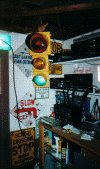 Here is a view of the signal shop
workbench. As you can see, it is always busy testing
"new" old controllers and signal equipment. The signal
in this picture is a Crouse-Hinds "combo" signal. It
has a 12" red indication and 8" yellow and green
aspects. This view also shows some of the Auto Club porcelain
signs that I also collect.
Here is a view of the signal shop
workbench. As you can see, it is always busy testing
"new" old controllers and signal equipment. The signal
in this picture is a Crouse-Hinds "combo" signal. It
has a 12" red indication and 8" yellow and green
aspects. This view also shows some of the Auto Club porcelain
signs that I also collect.
Here is a view of a Crouse-Hinds art deco signal with a very rare arrow lens. These lenses were discontinued in the early 70's because of driver confusion at longer distances. Also pictured are Econolite and Eagle controllers and some old porcelain signs.
![]()
Darley
W.S. DARLEY 4-WAY- Darley signals were mainly manufactured in the 1920's up till the beginning of WWII. The earliest of these signals used one lamp and a "cone like" reflector system to direct light from the lamp to the four lenses. This system proved very inefficient because the lamp was behind the reflector instead of in front and most of the light was lost, as the only reflected light was bounced into the reflector from the front lens. The example I have here is a later version beacon that has separate lamp/ reflector assembles for each lens. This signal is also unique in that it has the mechanical flasher unit installed in the base of the light. All that is needed is the supply power. This signal also has the compass directions (N,E,S,W) cast onto the roof of the signal.
And this is the 12 light non-adjustable version of the signal. This signal also sports 12 individual lenses and the controller installed inside the bottom plate. The cycle is fixed at 40 seconds with main street getting 25 seconds and the cross street with 15 seconds. This signal also features the green/yellow interval before red and on the cross street, green /yellow then yellow/red intervals before red. One other special note is that this signal represents my 100th signal acquisition!!
![]()
Eagle

 EAGLE
SIGNAL- This is one of the oldest signals in my
collection. Its an Eagleux
flashing 3 way beacon with a date (stamped on the inside) from 1936. It's in
original condition except for a newer coat of paint and one red
lens. All the wiring, reflectors, sockets, and yes, the CAUTION
lenses are originals. There is even an old "skeleton
type" key attached in the housing for the flasher box that
controlled it!
EAGLE
SIGNAL- This is one of the oldest signals in my
collection. Its an Eagleux
flashing 3 way beacon with a date (stamped on the inside) from 1936. It's in
original condition except for a newer coat of paint and one red
lens. All the wiring, reflectors, sockets, and yes, the CAUTION
lenses are originals. There is even an old "skeleton
type" key attached in the housing for the flasher box that
controlled it!
Eagle signal was probably the most popular signal purchased in most of America in the 1950's and 60's. The sale of Eagle products at a modest price were most popular in the heartland, and controllers and signals began to pop up in even the most smallest of towns. It seemed that every town wanted to have it's own "stoplight" to slow traffic and increase a town's revenue in shopping and in law enforcement! This particular signal was used in Pella, Iowa, and my father learned to drive during the era that it was in use. This signal was mounted to a street light pole for many years, and it had to be cut away because of the many years of winter and corrosion! The example pictured here is the one of the earlier Eaglelux models produced in the 1930's and 40's.
EAGLE 4-WAY- Pictured here is Eagle's version of the 4-way signal. These signals were usually placed by themselves over the roadway without any auxiliary signal faces in the same direction. Of course, if a lamp would happen to burn out, there wasn't any way to determine what color was supposed to be displayed. Many right angle accidents would occur because of oversimplified installations. The Eagle 4-way was one of the most popular "1st and Main" guardians of mid-western, small town America traffic control, and was fairly popular in the Western cities as well. This signal hails from Nashville, Tennessee.
* EAGLE COMBO W/ PEDESTRIAN SIGNAL- As with other signal manufacturers, Eagle signals came in a variety of styles and colors. Also, signal contractors would cannibalize some signals to upgrade to newer ordinances. This particular signal uses a newer Alusig 12" red section on top of the older, 8" aluminum body. The pedestrian signal is a 9" unit with incandescent lamps. Many contractors preferred having both vehicular signals and pedestrian signals to use the same lamps for easier maintenance. Both signals sport the older "cut away" type visors.
ALUSIG-This version of Eagle's aluminum signal was produced from 1977-1990. It featured polycarbonate lenses and alzak aluminum reflectors. There are many examples of these still out on the roads today.
![]()
Econolite
 ECONOLITE'S
FIRST TRAFFIC SIGNAL- This is one of the few "traffic signals" that were
manufactured by Econolite back in 1933. It consisted of a standard stop sign
with a red light installed in the top part of the sign. The flashing action of
the red light was run magnetically with a circular disc and a moving
contact...no motors were used! There is also a picture of one of these on Econolite's
website, in the
"History"
section.
ECONOLITE'S
FIRST TRAFFIC SIGNAL- This is one of the few "traffic signals" that were
manufactured by Econolite back in 1933. It consisted of a standard stop sign
with a red light installed in the top part of the sign. The flashing action of
the red light was run magnetically with a circular disc and a moving
contact...no motors were used! There is also a picture of one of these on Econolite's
website, in the
"History"
section.
ECONOLITE SIGNALS were probably the most installed signal in California. One of the signals that were very popular were the "combo left arrow" signal. This signal used a 12" green arrow indication along with 8" red and yellow sections. The smaller sections utilized a 3 or 5 section "louver" system to help block the view of the signal from adjacent lanes of traffic. These signals were normally placed in the median of the roadway and placed "back-to-back" with the upper signal controlling the left turn lane directly across the perpendicular cross street, and a lower signal close to the left side, opposite left turn lane. The signals have begun to fall victim to the "all arrow" 12" heads, as well as removal of the signals from the medians in favor of longer mast arms.
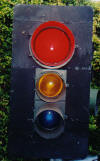 The
Econolite combo signal shown here was another popular signal because of the
larger 12" red indication. Many municipalities preferred this signal because of
the better visibility of the red lamp. Basically, this signal was a kind of
"transition" signal to the eventual change to all 12" indications. This signal
sports a newer LED red indication.
The
Econolite combo signal shown here was another popular signal because of the
larger 12" red indication. Many municipalities preferred this signal because of
the better visibility of the red lamp. Basically, this signal was a kind of
"transition" signal to the eventual change to all 12" indications. This signal
sports a newer LED red indication.
* ECONOLITE 8" WITH ICC NEON PEDESTRIAN SIGNAL- This signal typifies the Southern California signal of the later 70's and early 80's. Many of the pedestrian signals still used word legends instead of symbols and vehicle signals were still largely of the 8" lens variety. While most of California used the 8" back plates (pictured here), Los Angeles typically used the thinner 5". Click on the picture to view the signal animation.
ECONOLITE 8" 2-WAY WITH NEON PEDESTRIAN SIGNAL- This is the best example of the signals that once populated Southern California during the late 50's through the early 80's. Every intersection in the downtown areas sported these 2-way, top-of-pole mount 8" signals with back plates and neon pedestrian signals. It has been sad to see these signals fall victim to the conversion to 12" signals, but it has been a joy to preserve several examples in the museum's "garden". The 2-way hardware includes a vertical terminal compartment for easily connecting the signal wires to the field terminals.
12" ADAPTER UNIT- Here is a view of one of my Econolite signals with a 12" adapter on the red section. These adapters bolt right onto the visor screws of the existing 8" signal section. All one has to remove is the 8" red lens, visor and reflector. Many older signals downtown retrofitted these in this way so they didn't have to remove the signal already in place. Note: Southern California signals typically use full circle visors, unlike most of the US. Not sure exactly why this is, but it's been the standard for many years.
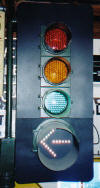 FIBER-OPTIC
ARROW SIGNAL- This is a fairly unique signal that you can only find in a few
states. The green and yellow arrow are enclosed in the same housing via fiber
optic lines that run from the appropriate lamp/color filter assembly to the
arrow itself. The one drawback to this particular kind of signal was that the
colorblind could not tell if the signal was green or yellow, because the arrow
didn't change position on the signal face like the more common 5 section faces
did! This signal is also using all LED indications.
FIBER-OPTIC
ARROW SIGNAL- This is a fairly unique signal that you can only find in a few
states. The green and yellow arrow are enclosed in the same housing via fiber
optic lines that run from the appropriate lamp/color filter assembly to the
arrow itself. The one drawback to this particular kind of signal was that the
colorblind could not tell if the signal was green or yellow, because the arrow
didn't change position on the signal face like the more common 5 section faces
did! This signal is also using all LED indications.
LED's are rapidly becoming more commonplace because of their longevity and reliability.
They also are highly energy efficient....only 10 watts vs. the usual 69 watts!
 A
Closer view of the inner workings of the fiber-optic signal. Note the two
projector lamps and color filters to project the appropriate color through the
fibers to the lens.
A
Closer view of the inner workings of the fiber-optic signal. Note the two
projector lamps and color filters to project the appropriate color through the
fibers to the lens.
ARIZONA-STYLE 5 LIGHT SIGNAL- This is an example of a combo signal with an 8" R-Y-G and 12" yellow and green arrows. This particular example hails from Arizona where black signals with extra long tunnel visors are the norm.
![]()
General Electric
* GE 4-WAY SIGNAL- General Electric was in the 4-way signal business also in the 40's and 50's and came up with their own version pictured here. The signal features screw on visors and embossed lenses with the GE logo. The signal also has a cast logo into the top pagoda. GE later sold out their signal business to Econolite in 1957 and stopped making 4-way signals. This signal is different form others because the reflectors clamp to the back of the lens. This helps to keep the reflector cleaner by providing a tighter seal between the reflector and lens. This signal hails from a remote intersection in Montana. Click on the picture for an animation of this signal.
GE STREAMLINE- These rather unique looking signals were produced in limited amounts from 1954-57. The body is made of thin stamped aluminum rather than the heavier and stouter cast aluminum. They also weigh considerably less and were much cheaper to make. GE discontinued this line when it sold it's signal line to Econolite. Today, only a limited number of these remain...mostly on the East coast.
* GE / ECONOLITE DOGHOUSE SIGNAL- This is an 8" version of the popular "doghouse" style protective/permissive signals that are becoming quite popular in America. Typically, this version is suspended over the intersection above the left turn lane that it controls. When the green arrow is lit, left turn drivers know they have a "protected left"...that is, the opposite signal for oncoming traffic is red. When just the green ball is lit, left turn traffic would then have a "permissive" green...they can only make their left when opposing traffic has cleared. Click on the photo to view the animation.
Harrington-Seaberg
HARRINGTON-SEABERG- One of the predesessors to Eagle Signal, Harrington Seaberg signals were known for their one piece design and "porthole style" doors. The reflecotrs in thes signals are quite thick and the signal is very ruggedly constructed. On the bottom, there is a place for an additional door to be fitted with an reflector and clear lens for a light. This would direct light down into the intersection and was used when a officer would direct traffic. As with Darley and Crouse Hinds signals, the Harrington has the four compass directions cast into the top. This signal is one of my favorites because of it's age and subtle details.
![]()
Marbelite
MARBELITE- Marbelite signals have been in business in one form or another for a long time. Though most signals were made and used in the eastern part of the U.S., a few made it to the west. Pictured here is their version of the 8" lensed 4-way signal. They can be distinguished by the lower pagoda on top and flat bottom. The top directions of the signal are marked "1,2,3,4 rather than the compass directions that Crouse-Hinds used. They also have their name cast onto the top and bottom of the signal. The lenses are the "large bead" variety and reflectors are all Lancaster Glass.
An early model of Marbelite signal with the ornamental "fins" on the top and bottom. Sometimes called an "art deco" by some collectors, this is increasingly a rare breed of signal to find. Most of these have vanished from our streets today. To me, this signal represents an era when aesthetic touches, such as these "fins" where more commonplace and manufactures took pride in making their product unique with subtle design features.
This is the newer 8" version of the Marbelite signal head. It featured rain drain holes in the back and riveted twist on visors. This is the second signal I obtained to be able to officially start a collection! I found this one in a dusty corner of an antique store. It was, and still is, in "like new" condition.
And here is the 12" version of their signal. When I originally obtained the signal, it was a battleship grey color. I have since repainted it to the back & yellow scheme you see here. The back side of this signal is one of the most unique I have seen. Click on the image to see a better view of the ornate back design.
![]()
Southern Autoflow
SOUTHERN AUTOFLOW- The Southern Switch Co, of Shreveport, La was originally a maker of electrical devices, relays, etc. I'm not sure of the exact date when they were formed, but probably in the early 1940's. In the early 1950's, they began manufacturing a line of traffic signal equipment, including 4-ways (Autoflow), and controllers. This eventually became their primary business, This example of their 4-way signal came from a small town in Arkansas. The signal is one that has a small controller mounted in the base. The old controller has a 40 second cycle and sequences the lights from green, to green/yellow/ then dark for a second before showing red. Signal also has unique "diamond pattern" lenses, and a rounded hanger at the top. The visors are riveted rather than screwed to the doors and are made of a very light weight aluminum.
![]()
Sargent Sowell / Teeco / TSI
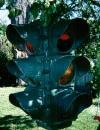 SARGENT-SOWELL- Here is
yet another 4 way
signal in my collection. It is
a bit newer than the
Southern Autoflow signal, but was
probably used in the early
60s. The signal was actually
manufactured by newly formed Traffic Signals Inc. out of Shreveport, Louisiana.
One of the unique things TSI did, was manufacture
"private label" 4-ways for other companies, most notably Sargent-Sowell,
of Texas. Basically, TSI would make the signals, and use
a different top casting, which had Sargent-Sowell's name cast in letters on the
top. There are at least three different designs of their 4-ways that evolved
over the years. today, this
signal is still being
manufactured by Teeco Safety
Inc. out of Shreveport,
Louisiana. An interesting
feature of this signal is that the control
mechanism was built right into the
bottom of the signal. One only
had to feed it power and the
signal ran on it's own on a
pre determined cycle. Boy,
life seemed simpler in those
days!
SARGENT-SOWELL- Here is
yet another 4 way
signal in my collection. It is
a bit newer than the
Southern Autoflow signal, but was
probably used in the early
60s. The signal was actually
manufactured by newly formed Traffic Signals Inc. out of Shreveport, Louisiana.
One of the unique things TSI did, was manufacture
"private label" 4-ways for other companies, most notably Sargent-Sowell,
of Texas. Basically, TSI would make the signals, and use
a different top casting, which had Sargent-Sowell's name cast in letters on the
top. There are at least three different designs of their 4-ways that evolved
over the years. today, this
signal is still being
manufactured by Teeco Safety
Inc. out of Shreveport,
Louisiana. An interesting
feature of this signal is that the control
mechanism was built right into the
bottom of the signal. One only
had to feed it power and the
signal ran on it's own on a
pre determined cycle. Boy,
life seemed simpler in those
days!
Traffic Control Technologies (TCT)
TCT.- Predecessor to Crouse Hinds, TCT continued to manufacture many of the vehicular and pedestrian CH signals using the original molds. This signal with 9" lenses sport the newer international symbols for WALK and DON'T WALK.
![]()
Traffic Signals, Inc.(TSI)
TRAFFIC SIGNALS INC.- Around 1961, the name of the Southern Switch company was changed to Traffic Signals, Inc. (TSI). The company continued to grow, and had a fairly extensive line of products in the 1960's.
![]()
LFE / Automatic Signal
12" ARROW LED SIGNAL- Another example of an all LED signal head. LED's are also quite bright and has the special feature that if one LED stops functioning, the others remain lit. It is quite interesting to note the "crispness" of how these signals change. They don't "fade out" like normal incandescent lamps do.
This photo shows the full size view of the signal with associated incandescent pedestrian signal. Signal stands 11' tall in my "garden"! The LED signal is made by LFE and pedestrian signal by Indicator Controls Corp.
![]()
Safetran
SAFETRAN- This signal once operated in the lone star state of Texas. Notice that it is horizontally mounted and is made of polycarbonate. Many states are going to these signals because of their lightweight design and lower maintenance...they don't have to be repainted because the color is part of the plastic. Safetran acquired Singer's signal division (see above) in 1978.
![]()
Wiley
WILEY SIGNAL- One of the prizes of my collection. The Wiley signal was manufactured about 1915 and the signals lasted in service until 1960. It features an eight sided revolving cylinder that oscillated 45 degrees to display the messages STOP & GO. The top "birdhouse is made of sheet aluminum with the base including the light housings made of cast iron. This signal has an internal bell that strikes when the signal banner rotates. The glass lenses are made by Kopp Glass and are quite heavy and well made.
![]()
Winko-Matic
WINKO-MATIC- Example of a 12" beacon made by this predecessor to Indicator Controls, Inc. Winko-Matic signals were never put into widespread use, but seem to show up once here and there among signal installations.
![]()
3M
 3M
8" PROGRAMMED VISIBILITY
SIGNAL (PV)-This is the 8"
version of 3M's limited
visibility signal. It uses two
integral lenses and a method,
via a aluminum foil type
masking, to mask the
indications from adjacent
lanes approaching the signal.
The special internal lens
"magnifies" the lamp and
create a more efficient
specific point of focus.
3M
8" PROGRAMMED VISIBILITY
SIGNAL (PV)-This is the 8"
version of 3M's limited
visibility signal. It uses two
integral lenses and a method,
via a aluminum foil type
masking, to mask the
indications from adjacent
lanes approaching the signal.
The special internal lens
"magnifies" the lamp and
create a more efficient
specific point of focus.

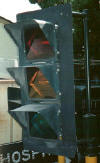 3M
12" PROGRAMMED VISIBILITY
SIGNAL (PV)- And here is the
more common 12" PV head. It is
an unusual signal in
appearance because of its
square lenses and "space age"
looking visors. This signal
uses the fresnel lensing out
front and uses 150
watt PAR 36 type lamps that are accessed through the rear door.
It features a safety door in that, when the door is opened the
lamp is "unplugged".
The signal also employs a
dimming capability to each
lamp, so as not to be too
bright at night.
3M
12" PROGRAMMED VISIBILITY
SIGNAL (PV)- And here is the
more common 12" PV head. It is
an unusual signal in
appearance because of its
square lenses and "space age"
looking visors. This signal
uses the fresnel lensing out
front and uses 150
watt PAR 36 type lamps that are accessed through the rear door.
It features a safety door in that, when the door is opened the
lamp is "unplugged".
The signal also employs a
dimming capability to each
lamp, so as not to be too
bright at night.
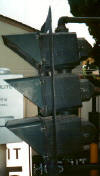 Another view showing the rear door access and cutaway
visors. The individual sections can be aligned left-to-right and
up-to-down by special pins between sections. In this way, the red
section can be tipped down lower than the green creating equal
"focus points" for all the sections. Also note the
bullet marks in the red section of this unit. When I first got
this unit, the red lens was broken and I found 3 bullets inside (probably from a frustrated motorist)!
Another view showing the rear door access and cutaway
visors. The individual sections can be aligned left-to-right and
up-to-down by special pins between sections. In this way, the red
section can be tipped down lower than the green creating equal
"focus points" for all the sections. Also note the
bullet marks in the red section of this unit. When I first got
this unit, the red lens was broken and I found 3 bullets inside (probably from a frustrated motorist)!
![]()
Signals from Other Countries
 BRITISH
SIGNAL- Here is one of the more rare signals in
my collection. It is a Plessey Tin Lantern from
England and dated from the
later 50s. It has the message
"STOP" embossed on the red
lens and also has a green
arrow indication. The signal
is surrounded by other old
signs that I have accumulated
over the years. Note the left
hand opening doors.
BRITISH
SIGNAL- Here is one of the more rare signals in
my collection. It is a Plessey Tin Lantern from
England and dated from the
later 50s. It has the message
"STOP" embossed on the red
lens and also has a green
arrow indication. The signal
is surrounded by other old
signs that I have accumulated
over the years. Note the left
hand opening doors.
GREEK SIGNAL- This is a brand new, out-of-the-box example of the signals used in Greece and other countries. They are usually made of polycarbonate and run on 10.5VAC. There is a transformer in each section to convert to the proper voltage to run the halogen lamp. Note the interesting "spider web" lens pattern. This signal is made by VRX Light Signal.
![]()
Pedestrian Signals

Home
/
Bio
/
Signals
/
Misc.
/
Signs
/
Controllers
/
History
/
Links
/
Faq's
/
Club/
HO Layout
All contents ©1997-2016
by Signalfan. All rights reserved.
